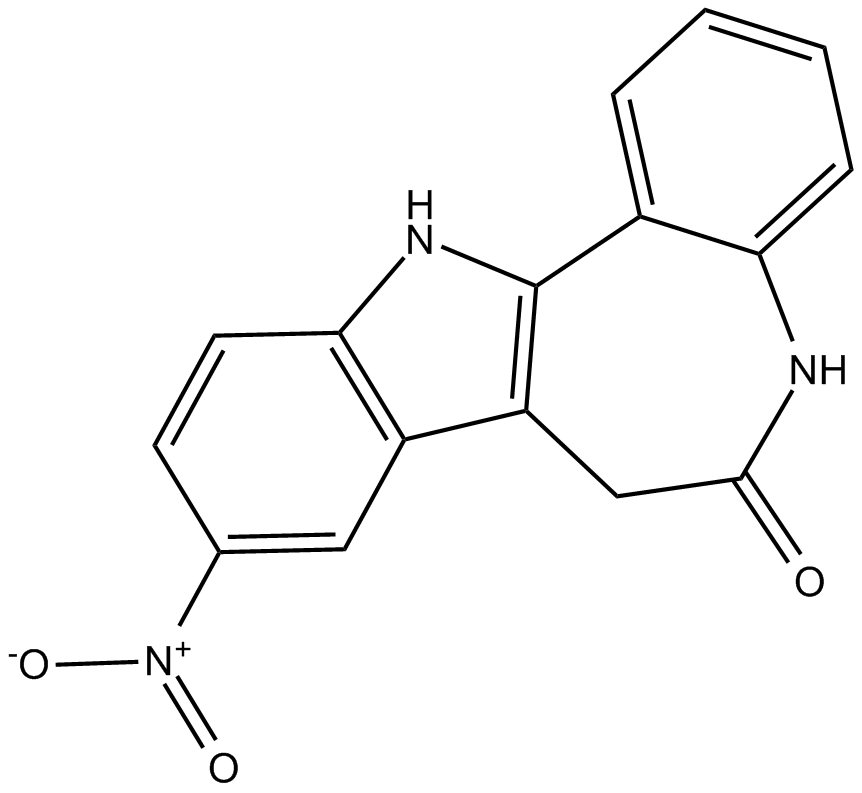Alsterpaullone (Synonyms: 9-Nitropaullone,NSC 705701) |
| Katalog-Nr.GC15841 |
Alsterpaullon (9-Nitropaullon) ist ein potenter CDK-Inhibitor mit IC50-Werten von 35 nM, 15 nM, 200 nM und 40 nM fÜr CDK1/Cyclin B, CDK2/Cyclin A, CDK2/Cyclin E bzw. CDK5/p35. Alsterpaullon konkurriert auch mit ATP um die Bindung an GSK-3alpha/GSK-3beta mit IC50-Werten von jeweils 4 nM. Alsterpaullon hat AntitumoraktivitÄt und besitzt Potenzial fÜr die Untersuchung von neurodegenerativen und proliferativen Erkrankungen. Alsterpaullon induziert Apoptose in LeukÄmie-Zelllinien.
Products are for research use only. Not for human use. We do not sell to patients.

Cas No.: 237430-03-4
Sample solution is provided at 25 µL, 10mM.
Alsterpaullone is a small molecule cyclin-dependent kinase (CDK) inhibitor [1,2].
Cyclin-dependent kinases (CDKs) are protein kinases that play important roles in the control of cell division and modulate transcription in response to several extra- and intracellular cues. Deregulation of CDKs is a hallmark of several diseases, including cancer, and drug-targeted inhibition of specific members has generated very encouraging results in clinical trials [3].
Alsterpaullone (Alp) induced apoptosis and promoted loss in clonogenicity in the Jurkat cell line. Alp activated both caspase-8 and -9, leading to cleavage of caspase-3 and poly (ADP-ribose) polymerase (PARP). Alp disrupted the activation of caspase-9 followed mitochondrial perturbation. Alp activated caspase-9 via mitochondrial perturbation [1]. Alsterpaullone regulated the cell cycle progression. Alsterpaullone inhibited HeLa cells in a time-dependent (0–72 h) and dose-dependent (0–30 μM) manner. Alsterpaullone arrested HeLa cells in G2/M prior to undergoing apoptosis via a mechanism that is involved in the regulation of various antiapoptotic genes, DNA-repair, transcription, and cell cycle progression. Alsterpaullone effectively prevented HeLa cells from entering S-phase [2].
References:
[1] Lahusen T, De Siervi A, Kunick C, et al. Alsterpaullone, a novel cyclin‐dependent kinase inhibitor, induces apoptosis by activation of caspase‐9 due to perturbation in mitochondrial membrane potential[J]. Molecular carcinogenesis, 2003, 36(4): 183-194.
[2] Cui C, Wang Y, Wang Y, et al. Alsterpaullone, a cyclin-dependent kinase inhibitor, mediated toxicity in HeLa cells through apoptosis-inducing effect[J]. Journal of analytical methods in chemistry, 2013, 2013.
[3] Malumbres M. Cyclin-dependent kinases[J]. Genome biology, 2014, 15(6): 122.
Average Rating: 5 (Based on Reviews and 28 reference(s) in Google Scholar.)
GLPBIO products are for RESEARCH USE ONLY. Please make sure your review or question is research based.
Required fields are marked with *




















